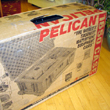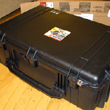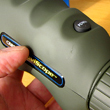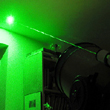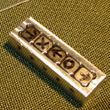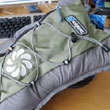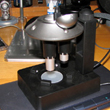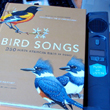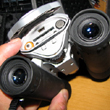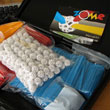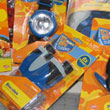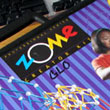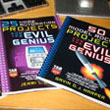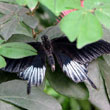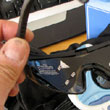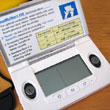|
|
 |
RainyDayScience's content can now be licensed for your print magazine or web site. Please contact us directly here. If you want to see something reviewed, then drop us a note with a link and we'll be happy to take a look.
|
| |
December 20,2008 (RainyDayGiftGuide) |
There were plenty of photography accessories reviewed in 2008. We expect to continue this trend in 2009. The best of the lot were chosen for this year's RainyDayMagazine Holiday Gift Guide. All of the items were tested using the Nikon D40, but there should be a version which will fit most of the popular camera brands. As with the other RainyDayGiftGuides, clicking on an item in the photos will bring you to that item on Amazon. Occassionally it may bring you somewhere (hint, hint) even better.

When we purchased our D40s, they came with the 18-55mm as part of the kit. But we wanted a longer zoom so we picked up the 55-200mm Nikkor VR lens. Both lenses have turned out to be real workhorses, but the 55-200mm VR lens has performed beyond expectations.
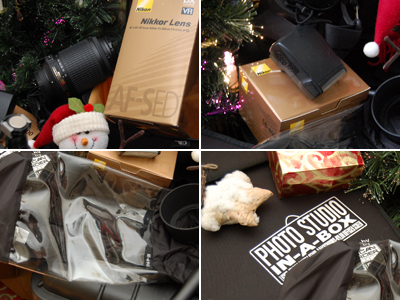
The D40 camera body has a built-in flash, but often a stronger light is needed. The SB-400 external strobe is compact, quite powerful, and designed for the new Nikon digital SLRs. For more control over lighting, American Recorder's Photo Studio In-A-Box sets up quickly, comes with everything needed (lights, backdrop, tripod) for a desktop photo shoot anywhere, anytime.

Digital cameras have a host of automated features which allow the photographer to concentrate on the composition rather then the technical details. However, it is the control over those "details" which is the reason why many of us opt for SLRs rather than point-n-shoot units. Lensbaby 3G lenses give photographer the kind of control no other lenses can. Go here to find out more. Go here to get one.
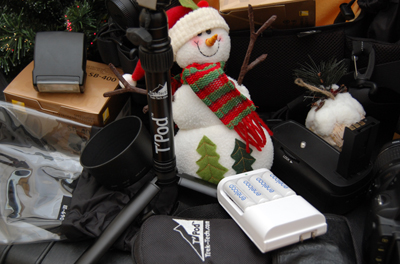
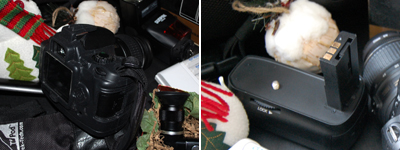
Other useful accessories readers may want to consider putting under the tree are items to power the camera (PowerGrip), protect it from bumps and bruises (CameraArmor), or to keep the camera dry (Kata E-690) during those inclement outdoor photo shoots. If the sun is too bright to read what's on the LCD, then a Delkin eFilm Shade will take care of the problem. We have one on our Nikon D40 24/7.
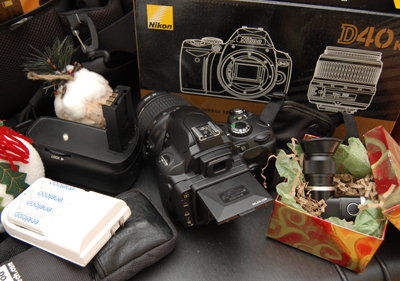
We can personally recommend these camera and photo accessories because we use them, sometimes everyday. If you want gear that can stand up to use but won't break the bank, then check out this collection. Happy Holidays. [Permalink] - RainyDay Photo Gear Guide
|
|
December 19,2008 (RainyDayGiftGuide) |
Books entertain, educate, and elevate all those who spend time with them. Books also make great holiday gifts. So whether you are interested in physics or fantasy, you will find something in this RainyDay Gift Guide for your favorite bookworm.

We have embedded links to Amazon to all of the items above. A click on the image of book will bring you to the Amazon page for that item. For a closer look at ones in this year's gift guide, click on any of the photos below.
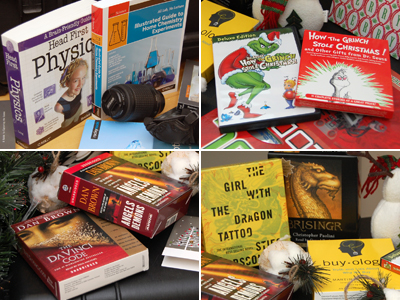
We would read all the time, but sometimes we have to keep our eyes on the road. For those times, we have audio books. Last year we spent many hours (144 x 3) listening to the Harry Potter series. This year we spent a good chunk of our commuting hours with two of Dan Brown's thrillers (Da Vinci Code, Angels and Demons). Recently, we picked up four new audio sets (Girl with the Dragon Tattoo, Brisingr, buy-ology, Breaking Dawn) for the daily back and forth. We'll let you know how we like them after the new year.

For those interested in digital photography, Rocky Nook published some excellent books on a wide range of topics (IR photography, fine art printing, HDRI). They also have some fantastic books for those just starting out in digital photography for fun or for EBay.
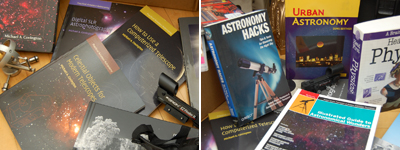
We didn't know so many RainyDayMagazine readers were amature astronomers until we started the RainyDayScience section. Now we get requests for and emails with links to Astronomy books all the time. Amongst our favorites this year were the Practical Amateur Astronomy series from Michael Covington. There were also some excellent ones (Illustrated Guide, Astro Hacks) published by O'Reilly in our collection. Happy reading! [Permalink] - RainyDay Books Gift Guide
|
|
December 18,2008 (RainyDayGiftGuide) |
Our staff has reviewed a lot of camera bags over the years, but we have stopped reviewing bags from makers other than Kata this year. It is not that other makers don't have good camera bags, it's that we think Kata makes the best ones out there.

We have used them to carry all kinds of digital and film cameras: small point and shoot like the Canon S100, larger fixed lens such as the Canon S2, and full size SLRs similar to the Nikon D40. They are also perfect for small telescopes and video gear.

If you have a small point and shoot camera and want to have quick access to it while on the move, then the S-312 sling case is what you will need. If you want the same type of mobility and access with a larger SLR, then the T-212 Torso pack is what we would recommend.
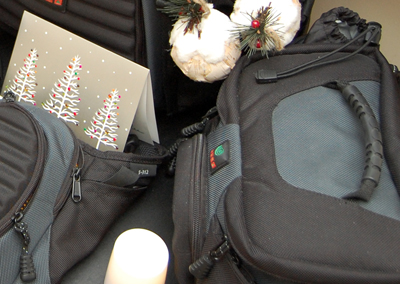
For those with a lot of gear, Kata makes many different sizes of shoulder cases, waist bags, and backpacks. Many of these can be combined to form a larger functional system (sling + waist, sling + backpack, etc...). We use Kata bags to carry our gear every time we go on location. We would not carry our gear in anything less. Neither should you. [Permalink] - Photo Bags Gift Guide
|
|
|
November 13,2008 (TriceratopsThursday) |
Who cost a million dollars, came in ten crates without assembly instructions, and is 65-and-a-half million years old? Cliff, the new, actual, triceratops at Boston's Museum of Science, that's who.

The cool thing about Cliff is that those bones (and all those teeth) really are his; this ain't no model, and all those bones came from the one guy (assuming at this point we can tell the difference between the Tri-sexes). Cliff might be surprised to realize that he is one of only four near-complete examples of his kind in the world, and the only one in the northeastern United States. All the skeletons that you see in museums are made up of bones from various finds.
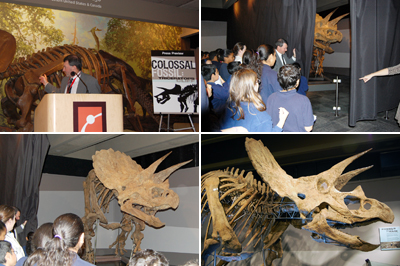
Cliff was discovered in 2004 in North Dakota in the Hell Creek Formation by a rancher. It was put up for auction in April of this year by Christie's Paris ("Pardon, monsieur, but there ees a dinosaur een your auction house"), and subsequently offered to MOS on long-term loan.

The donor, who wishes to remain anonymous, enjoyed coming to MOS when he was a child, and thought the museum would make a good home for the 22-foot long, 2,000-pound fella. "We got a phone call in the Spring, asking if we'd like a dinosaur," Ioannis Miaoulis, MOS Director and President, told the crowd before the literal unveiling of Cliff.

Cliff is named for the anonymous donor's grandfather (who must be really old himself). Additional remarks were made by Dr. John Hoganson, State Paleontologist of North Dakota.

Cliff now, uh, lives, in the Dinosaurs section, and in the exhibit is numerous other dino-stuff (but don't step in the footprint of the T-Rex, he might get annoyed). There are other interactive pieces being offered by the museum to enhance the paleontological experience, including the IMAX movie Dinosaurs Alive! [Permalink] - Triceratops Cliff
|
November 12,2008 (WowUsWednesday) |
Cats can see really well in the dark. Everyone knows this. Seeing a cat in the dark would be a lot easier if they were all like Mr. Green Genes.

Mr. Green Genes is a cloned cat whose DNA was manipulated during his creation. We are guessing that the fluorescence gene, probably from a jellyfish, was introduced during the cloning process. Notice the green on Mr. Green Genes' nose and around the edges of the ears. If shaved, his entire body would be glowing green.
This "glow" technology, while fun, does serve a very useful purpose. It lets scientists track the activities inside a living cell. Imagine if only cancer cells were to "glow" or if the developmental path of a stem cell could be tracked via different colors over time. We can learn how and when a generic stem cell differentiates into something more specific. The potentials are quite exciting. Still, not a cool as a glow-in-the-dark cat :-) [Permalink] - Mr. Green Genes
|
|
|
We fixed the Celestron ASGT mount almost two months ago, but have not had a chance to attach a scope to it yet. The problem was neither of our two telescope optical tubes have rails attached.
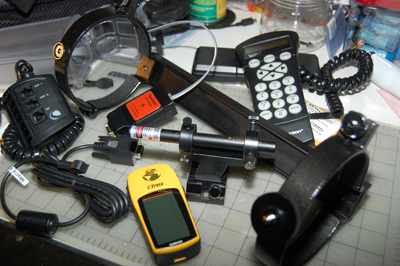
For the past few months we have been putting the pieces together to mount the Meade 2045 tube, add a GPS unit, and a laser pointer. We think we have finally got all the items assembled.

To get the GPS working, we needed an adapter and some extra ports. To attach the laser pointer, we needed a mount. To attach the optical tube, we needed a rail and some rings.
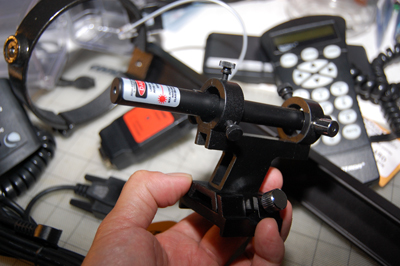
It will be fun to finally be able to test out the Celestron mount. Look for some deep space shots in the future. [Permalink] - Telescope Mount Accessories
|
|
|
|
Yesterday we looked at the Zen mind, today we want to feed the geek mind. The best way to do that is with a tech toy. The CyberCube is such a toy.
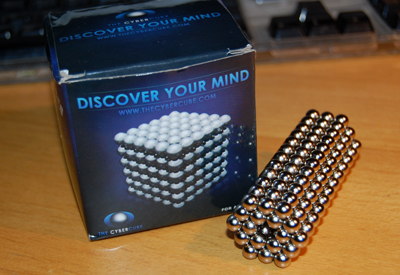
The CyberCube is made with 216, 6mm, neodymium spherical magnets. They are surprisingly strong and sometimes they act like they have a mind of their own.
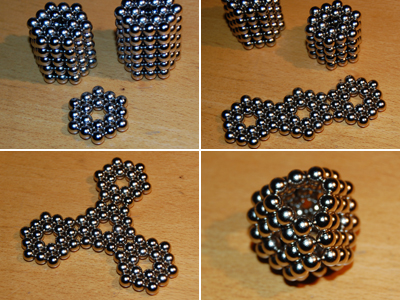
One of the "natural" configurations for these magnets is the flat hexagon, but it's the three-dimensional shapes which arise from connecting the hexagons that are really interesting.

The geometric forms are obvious, but we found the more organically-shaped ones to be more interesting. The possibilities are really limitless. The hardest shape to make? For us it was the cube! It took us quite a while to figure out how to get the face to be square. The magnets kept wanting to slip into a "rounder" configuration.
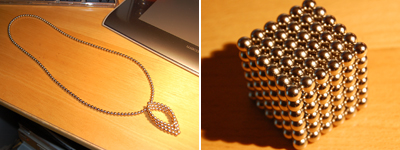
The CyberCube is a great toy for anybody, for any reason, at any time. Get one for a friend if you have a reason to give a gift, but definitely get one for yourself today. [Permalink] - CyberCube
|
|
|
We have been waiting for the right opportunity to photograph the Wicked Laser InTheWild. We brought it with us to Maine, hoping there would be a few clear nights so we could get some photos of it in action.
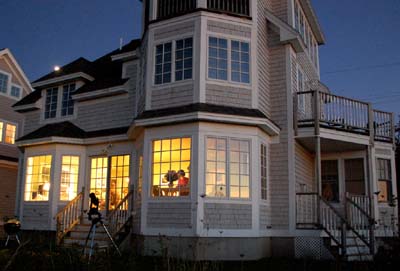
The first night we set up the telescope and took a few experimental shots to establish the settings needed to capture the laser.
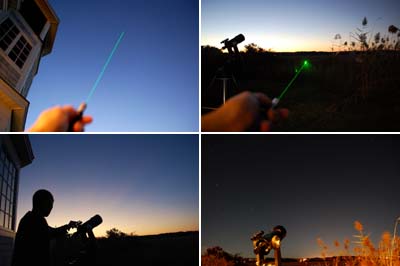
At first, we had a little trouble keeping the laser from moving. It took a bit of trial and error to get the shutter timing right, but once we got it worked out, the shots came out a lot sharper than we thought they would.
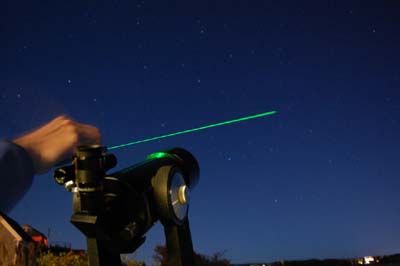
Some were skeptical that the laser could even be seen at night, but there was enough dust in the air to scatter the light and make the laser visible. It was quite amazing to be able to point at individual stars with the Wicked Laser and have someone else see what you were pointing at.
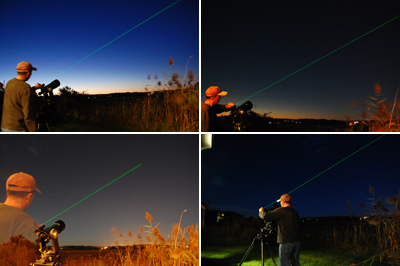
The beam from the Wicked Laser is very bright and will be easily visible at dusk. It will be a useful addition to anyone's astronomical toolkit. It is not a toy and must be used responsibly. BTW, we wouldn't point a laser up in the night sky in the city for the off chance that we would accidentally "light up" an aircraft and temporarily blind the pilot. The FAA takes a rather dim view of these "accidents." [Permalink] - Wicked Laser InTheWild
|
|
|
|
The Harvest Moon has been in the New England sky for the past few nights. However it has been hidden by the cloudy weather. Being the optimists that we are, we had the telescope set just in case the cloud movements cooperated. Our patience was rewarded by a brief appearance around 10:40PM.
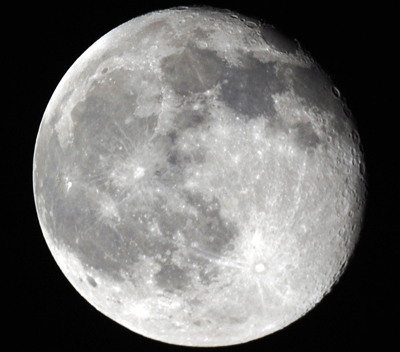
We took a series of photos of the full moon using our normal setup (Nikon D40, angle viewer, Meade 2045). The angle viewer definitely made it easier to make fine focus adjustments of the telescope. However, we noticed that some of our past shots were ruined by some vibrations from pressing the shutter button.
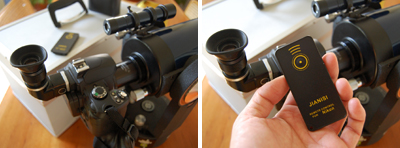
In an effort to eliminate that problem, we purchased a remote trigger to fire off the shot. After shopping around, we purchased this one on EBay. The cost? $5 ... and that included the shipping from China!
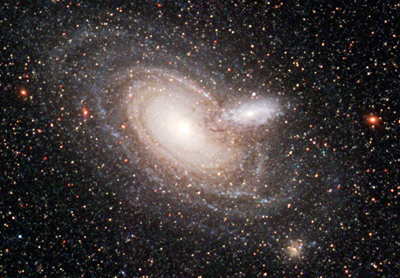
Our earth-based astrophotography images may not be as cool as this one from the Hubble telescope, but we are slowly learning and having a lot of fun doing it. If you are looking from some new photographic challenges, we urge you to give astrophotography a try. It is surprisingly addictive! [Permalink] - Harvest Moon
|
|
|
We got one awesome book in the mail from DK Publishing yesterday. It is "Cool Stuff Exploded" by Chris Woodford (ISBN: 978-0-7566-4028-6). Everyone has heard the saying, "you can't judge a book by its cover." Well, in this case, we think you can.

The "Cool Stuff" in the title refers to things like digital cameras, cell phones, and watches. The "Exploded" part refers to how the insides of those things are represented in the book.

A taste of the 3-D exploded views inside the book is right on the cover. Tilt the cover to one side, the Lego robot is in its normal form, move it a bit and it will start to come apart. Hold it just right and you will see it in its "exploded" glory! VERY, VERY, COOL!

Everyday things are not the only things "exploded" in the book. Exotic items such as fuel cell cars, sonic washers, and Flexi phones are also on the list.

Some of you may be thinking...it would REALLY be cool if they would animate the "explosion." Well, the author thought of that and included a CD with fifteen animated "energetic disassembly" of the items from the book.

The illustrations in the book are extremely well done. They span both pages and are in great detail. Accompaning the drawings are technical specs and interesting facts.
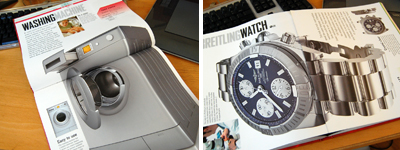
Each item is followed by a stunning "exploded view" showing the relationship of each piece relative to the whole. The illustrations are both educational and just plain fun to look at.
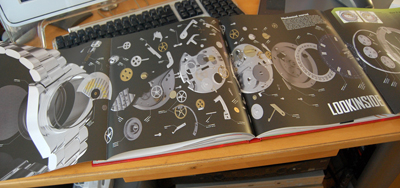
When thumbing through the pages, we noticed that the ink-jet printer in the book was quite similar to the Canon iP4000 we have in the office. We have always wanted to take it apart to see what it looked like inside. Now we don't have to :-)

If you have someone who is constantly taking stuff apart to see how it works, get them this book. They will LOVE it. If you have someone who is constantly taking YOUR stuff apart, get them this book. YOU will love it. [Permalink] - Cool Stuff Exploded
|
|
|
|
We have been watching Hurricane Ike's progress on the web. One of the nicer interactive tools we've come across is this map from MSNBC.
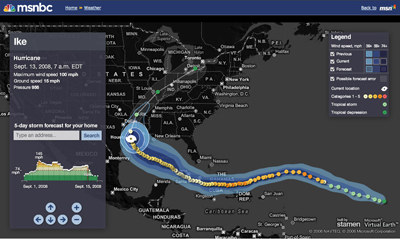
The MSNBC map shows the past, present, and future path of Ike in a clear, easy to understand format. User can zoom in, pan around, and get the current stats (wind speed, pressure, etc...) of the storm.
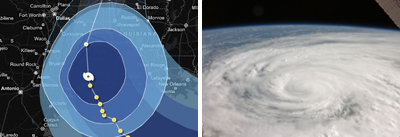
For readers interested in photos of Ike from space, we would recommend heading over to the NASA site. They have some amazing shots of Ike taken from the Space Station. [Permalink] - Ike is here
|
|
Ike is just hours away from the coast of Texas. By tomorrow morning, Galveston may be underwater. The weather service has been warning residents to get out of town or face "certain death." Well, the message couldn't be any clearer than that.
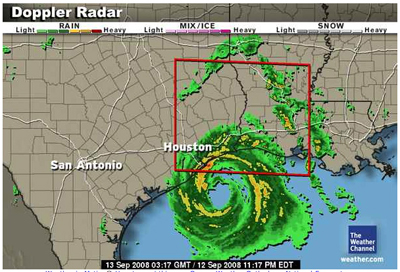
However, about 10,000 residents of Galveston have decided to stay and ride out the storm. While there is always a glimmer of hope that the storm may shift or fade at the last minute, it seems crazy to ignore a clear warning of "certain death." We wish them luck because it is now too late to change their minds. [Permalink] - Ike
|
|
|
When we say that some of us here are physics geeks, we want RainyDayMagazinze readers to understand the full meaning of our statement. We read books on cosmology for fun and relaxation.
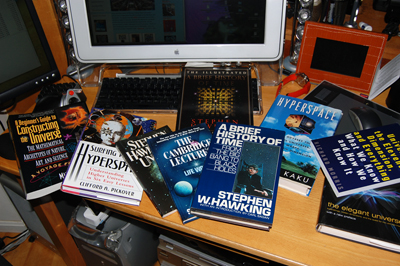
All of these books were bedtime reading for our editors at one time or another over the years. So yes, we are quite excited about the particle physics experiments beginning at CERN today. And no, don't send us any emails about "a blackhole that will swallow up the earth."
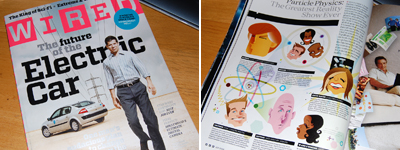
For readers who want a quick refresher on the basics of particle physics, Wired magazine has a wonderfully tongue-in-cheek primer in their September issue. It is not everyday the world gets a glimpse of the mind of God. Today may be that day. Actually, it will more likely be the latter part of October as the scientists are just firing up the puppy today. So there is still time to read up and be ready!
[Permalink] - Particle Physics and Hyperspace
|
|
|
Everyone in the RainyDayScience department is eagerly awaiting the results from the Large Hadron Collider experiments tomorrow.

There have been plenty of "the sky is falling" fears and pseudo-science hand-wringing about the LHC expressed on the Net these past few weeks. It is good to see that CERN has basically ignored these nut-jobs (in case it is not clear, we have little patience for ignorance around here) and will go ahead with their experiments. We are looking forward to better understand the world around us. Those out there thinking the world is going to end on Wednesday... well, you should just go have a "farewell" party. [Permalink] - Large Hadron Collider
|
|
|
When we last left our disabled Celestron CG-5 mount, we were flummoxed as to why our bypass of the power switch did not bring the unit back to life. Upon closer inspection, we finally understand the problem.
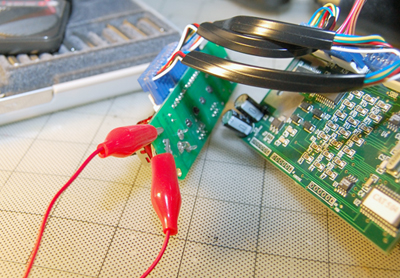
There was some kind of lacquer around the contacts of the power switch. It worked when we clamped our bypass to the solder points on the BACK of the board.
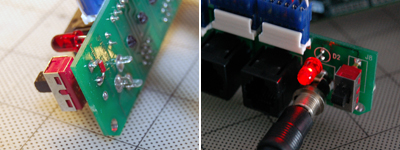
Once we confirmed that the power switch was the problem, we had a few options. Celestron quoted us $35 for the board. It was a fair price if we wanted to just replace the entire board. However, this problem could be resolved just by bypassing the switch with a wire.
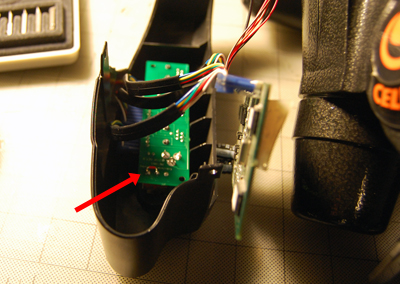
What we could not confirm at this stage was whether or not the rest of the electronics were functional. We had to reassemble the unit and test it with the controller to see. This is a pretty well laid out mount. Getting the two boards back into the holder and reattaching everything was pretty simple.
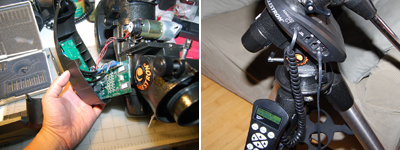
We all held our breath when we plugged in the AC power. The power LED came to life and the display on the controller started scrolling text. Yay!!! At least all the electronics appear to be working.
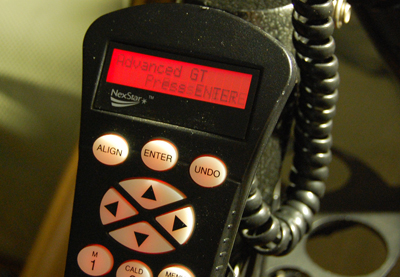
Now that we have confirmed that the electronics are "alive," we need to hook up a telescope to the mount to see if it will actually point to something. According to a few readers, this mount will also accept a GPS accessory. It might be an interesting accessory to check out at some point. [Permalink] - Celestron mount revived
|
|
|
|
There was a Celestron CG-5 ASGT mount for sale on Craigslist a few weeks ago. The seller had too much equipment and was looking to pare down his collection. We had been looking for a GoTo mount, so we worked out a reasonable price and drove for about an hour from Boston to pick it up.
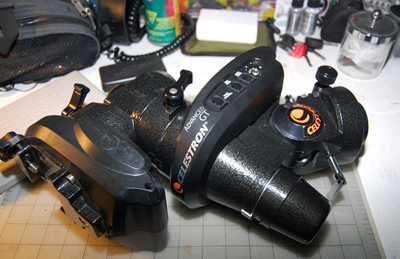
The mount, parts, and tripod were exactly as described. We were set to do the deal when the seller thought it would be useful to power it up and demo some of the basics. Well, long story short, as with all demos...what worked perfectly 10 minutes ago will break once you try to show it to someone else.

After fiddling with it for about 20 minutes, we decided something must have fried after his last potential-buyer demo. Since we had come all that way, it seemed a shame to go home empty-handed. The mount was in great shape and we thought it would make for an interesting repair article. I mean, how complicated could these things be anyway? So we worked out a new price and droe the CG-5 to its new home to see if we could bring it back to life.
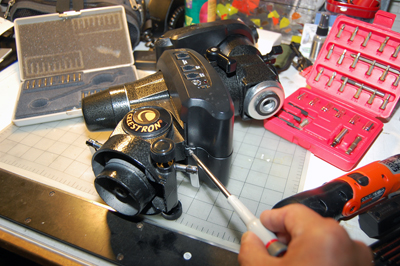
Once we got back to the office, we took a closer look at the mount. The unit is heavy and well constructed. It appears all of the electronics were contained in the plastic housing wrapped around the core. We identified three screws holding the casing together.

Removing the three screws required three different tips. Once removed, the case came apart easily, exposing gears, a motor, and some circuit boards.
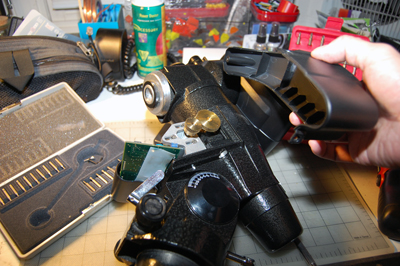
Since we had no idea what to expect, we went slowly and documented every step. Fortunately, the construction was fairly straightforward and quite roomy.
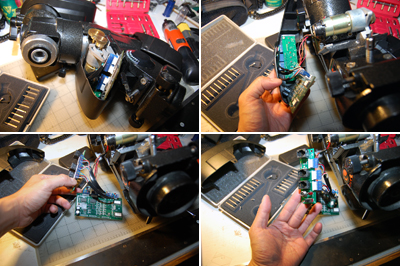
All of the circuitry were on one side. The board with all of the sockets were screwed down to the cover. Removing the screws freed the board. The other circuit board was held in place by some internal slots and was easily freed by gently sliding it out. Three connectors connected the two boards together. The connectors are all the same so we made sure we noted their original positions.
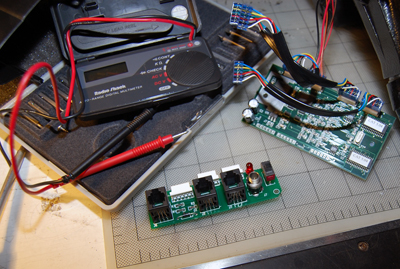
With the power board freed, we were able to confirm there was power coming out of the AC adapter and going into the board. The switch definitely did not appear to be working. The odd thing was when we bypassed the switch, the LED still didn't power up. This was a surprise but unfortunately, we will not have time to follow up on that until the weekend. To get things rolling, we placed a call to Celestron for a quote on how much it would cost to replace the electronics. Word on the Web is they are REALLY slow in responding. We'll see how this works out. Anyone with a broken CG-5 with some good electronics parts out there? [Permalink] - Celestron CG-5 ASGT mount
|
|
|
|
The image on the left is the one taken on Friday night and the one on the right taken on Saturday. We took both using the Nikon D40 and the Meade 2045 telescope.
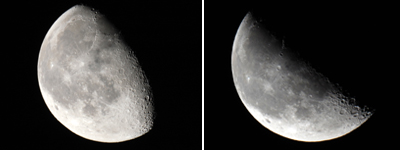
One parameter we did not control for in this comparision was the exposure time. The exposure time will affect the amount of noise and contrast in the image. We know the one on the right was taken at 1/30th of a second. It is fairly obvious by looking at the craters that we were able to achieve a sharper focus by using the angled viewfinder.
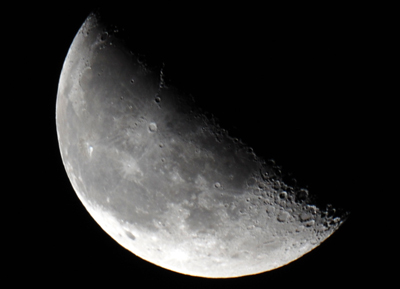
The images below show approximately the same area on the moon. The one on the right definitely shows greater detail. It was likely due to better focusing, but we may also have been better at not disturbing the shot. We'll eliminate that variable in the future by using a remote trigger.
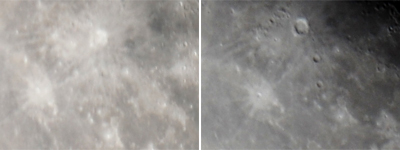
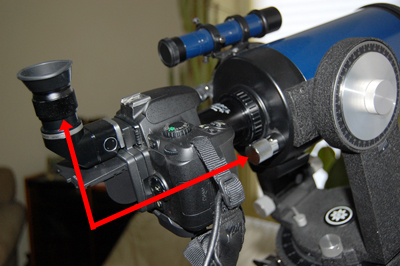
This outing made us realize we need to adjust and "lock in" the focus on the viewfinder when it is still light out. It was tricky trying to both focus the viewfinder and the telescope as we couldn't tell whether one or both were out of focus at the beginning. [Permalink] - More Moon Shots
|
|
Last Thursday night we made our first attempt at photographing the moon using the Nikon digital camera coupled to the Meade 2045 telescope. The results were acceptible considering we really didn't know what we were doing and were learning as we went. One thing we did notice was that getting the moon in focus via the viewfinder of the camera was not that easy. In this day and age of "autofocus", the viewfinder is more used for composition than for critical focusing.
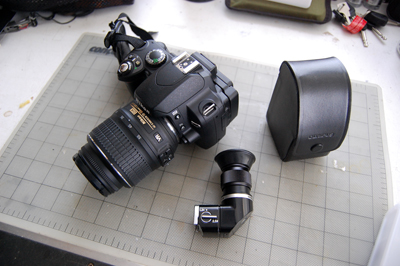
Folks in the RainyDayPhotography department mentioned they had an angled viewfinder for the Olympus OM film system and perhaps we could adapt it for use with the Nikon D40.
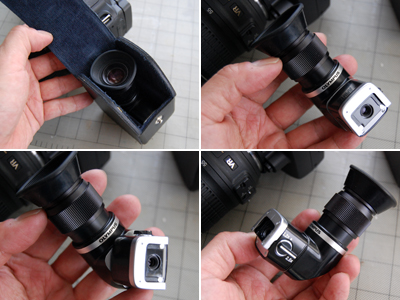
The Olympus angled viewfinder is a high quality piece of gear. Most of the parts are made of metal, no play in any of the parts, and the action is smooth. On the side is a lever for flipping between the two magnification levels of the viewfinder.

We did encounter a slight problem when trying to mount the Olympus viewfinder on the Nikon body; the channel in the frame of the eyepiece was not narrow enough. We considered a few different options (changing the frame, finding an adapter, etc...) but finally realized that if we deepen the channel, things should fit together. So out came the Dremel and the routing tip. However, just in case we were wrong, we decided to make the adjustment to the Delkin shield instead of to the camera.
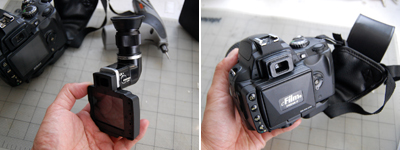
We made the changes slowly and did test fits with the Delkin shield detached from the camera. After a few tries, we got it properly fitted.
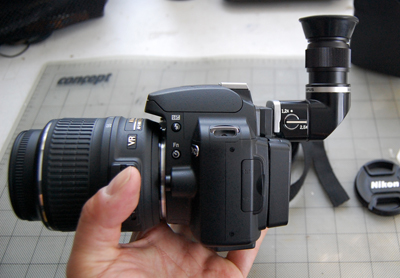

The angle viewfinder should enable us to both see the image more clearly and better adjust the focus on telescope before taking the shot. We are eager to give this setup a try. It is still clear out so we should be able to take some more shots of the moon tonight. We'll post some comparisions tomorrow. [Permalink] - Angled viewfinder
|
|
|
|
We took the Nikon-mounted telescope out last night for our first astrophotography session. Moving the rig outside was a bit of a challenge. We see now why it's good to have an observatory :-)
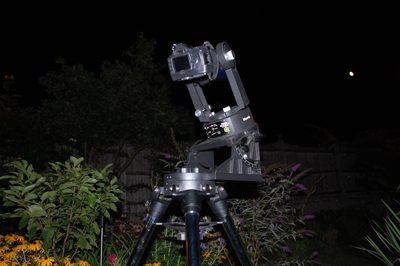
We had to wait until after 11:30 before going outside because we were watching the first ever Olympics BMX finals in the office. By the time we got things set up, the moon was high in the sky. It was past full, but plenty of craters were still clearly visible.
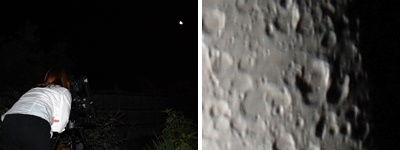
We took a whole series of shots at different exposures. The best ones were with the shutter at around 1/30 of a second and using the self-timer mode. Focusing was a lot trickier then we had anticipated as the image through the viewfinder is kind of small, making critical adjustments more of a hit-or-miss proposition. Nontheless, we got a few reasonable images. Here is one at full res...check out those craters!
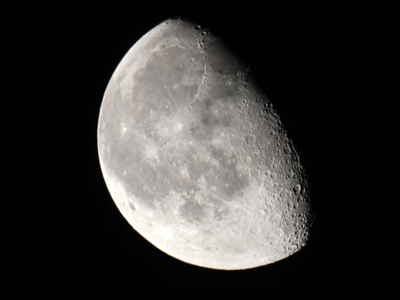
This outing was much more successful then we would have expected. Using a digital camera had a lot to do with that. The ability to quickly check the exposure was critical for us getting good images as we had to use the manual mode for the shoot. The various books we have been reading on astrophotography also helped quite a bit. We learned a lot from this first attempt. There is a long way to go before we can hope to get images like the one we posted on Wednesday. [Permalink] - Moon shot
|
|
|
The weather has been perfect this entire week, warm during the day, cool at night, and not a cloud in the sky. Taking advantage of the remarkable stretch of good stargazing conditions, we have been taking the Meade telescope out every night.
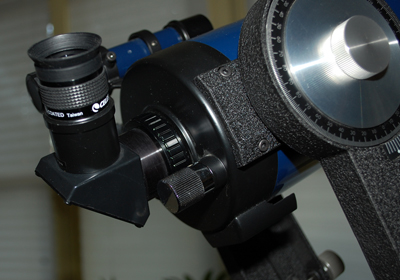
Mostly we have been looking at Jupiter and the moon. As we are just starting out in Astronomy, we spent a great deal of time playing with all of the different eyepieces and getting a better understanding of the basics of the scope. However, our eventual goal is to get comfortable enough the telescope to take some photos with it.
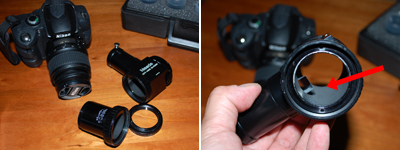
When we purchased this Meade 2045, it came with accessories for attaching a camera to the telescope. One is a normal T-mount with a Nikon adapter. The other is an Off-Axis guider (OAG). The OAG has a small mirror to reflect an image up to the eyepiece so one can check and correct any tracking problems during long exposures.
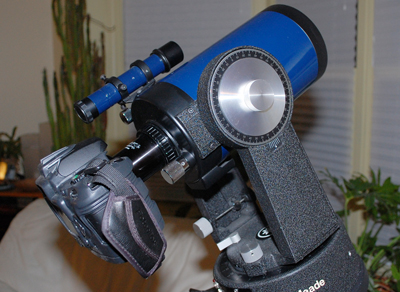
For photographing closer objects such as the moon, we'll be attaching the Nikon to the scope using the T-Mount. This is a quick and simple setup and is the same for the T-Mount and the OAG: the camera adapter is threaded onto the mount, the mount is threaded onto the telescope, the camera twist-clicks onto the adapter like you were attaching a regular lens.
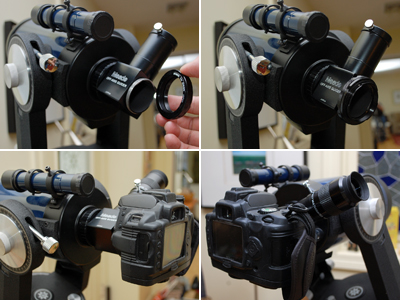
Once everything has been mounted, focus can be done through the camera's viewfinder. Note that the Nikon D40's autofocus will not work when attached to the telescope, as the focusing mechanism for this camera is actually in the lens, not the camera body. We'll post some of our first attempts later this evening. [Permalink] - Astrophoto prep
|
|
|
No doubt some have heard about the "Bigfoot" carcass found by a couple of yokels. The incredible part of the story is not their claim that they "found" Bigfoot, but their thinking they could get away with it. One of these guys is actually a police office, for god sake. Has he never seen CSI on TV? But this post is not about that. It is about the fact that if folks want to find something amazing all they have to do is just look up in the sky!

We don't remember who sent us this image of a "heart" made of stars, but we filed it away because we thought it would be perfect for a "WowUsWednesday" post. There is no need to go making up fake "discoveries" using a rubber gorilla suit. There are plenty of wonderous things waiting to be discovered just by looking up!
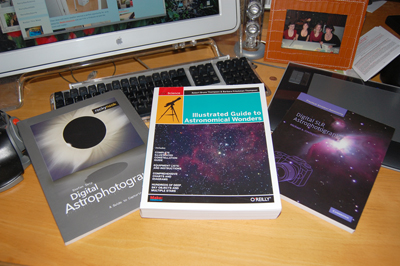
The folks in the RainyDayPhotography department have been reading up on Astrophotography so they can experiment with the new telescopes using the Nikon D40. Their first attempt will be some shots of the moon. We'll see if they can find it. [Permalink] - Heart of stars
|
|
|
We know the Olympics are still going on, but both the full moon and Jupiter are high in the New England night sky this week. Jupiter is so bright that it is easily visible to the naked eye at dusk.

Clear skies and warm weather seemed a perfect opportunity for us to setup the Meade telescope and use it for a FirstLook at both the moon and Jupiter.
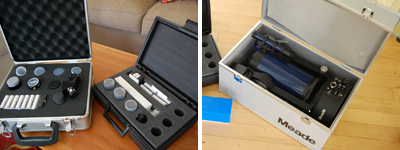
When we purchased this Meade telescope back in March, it came with a few cases of accessories (objectives, filters, etc...). In this FirstLook, we hope to try all of the eyepieces to understand their differences.

Since we are not that familiar with this telescope, we thought it best to assemble it inside and then move it out. The scope was pretty simple to put together. Just three screws and it is ready to go. We will not be aligning it or using the automatic tracking this time out. We just want to see what we can see :-)

With the scope out at the front of the building, we pointed it at Jupiter, and was treated to an amazing sight. We could clearly see the bands of Jupiter and some of is moons. We have alot to learn about using this telescope, but we will be bringing it outside every opportunity we have. Even in the middle of the Boston, with all of the street lamp and ambient light, there are still a lot of things to see in the night sky. [Permalink] - Meade 2045 FirstUse
|
|
|
|
At this point, pretty much every one on the planet knows about Harry Potter and Michael Phelps. Like the boy who survived, Michael Phelps managed to pull victory out of certain defeat at the last possible moment. In this instance, that moment was a difference of 0.01 seconds. The same thing happened a few days later with Dara Torres, except this time she lost to Britta Steffen of Germany by 0.01 seconds.

While watching the events, we got to wondering: just how fast IS one one-hundredth of a second? We know that light travels at a little faster than 186,000 miles a second. So, in 0.01 of that second a photon would travel 1,860 miles, which is about the distance between Boston and Rapid City, SD. OK, perhaps that example didn't really clear anything up. Maybe the following examples will make it a little easier to relate to 0.01 seconds:
- blink of an eye: 5 times/sec = 0.05 blink in 0.01 sec
- hummingbird wings: 3.3 beats/sec = .03 beats in 0.01 sec
- bumblebee wings: 130-240 beats/sec = 1 to 2 beats in 0.01 sec
So, 0.01 seconds turns out to be about the time it takes for a bumblebee to beat its wings once or twice. Wow, those were REALLY close races :-) [Permalink] - One one-hundredth of a second
|
|
A few of us recently saw a play by Peter Parnell called QED, a really funny and really amusing play about Richard Feynam. People who know his name might know it from the Nobel Prize he won in 1965 for his work in quantum elecrodynamics (QED), or they might know it from his being the guy who explained why the O-rings caused the Challenger disaster, to wit: "when they get cold they break."
The play was the result of an initiative call the Catalyst Collaborative@MIT (CC@MIT). Its goal is to examine science and its role in society via entertaining and thought-provoking means. QED's run at the Central Sq theater ended on August 9th. We didn't hear about it until its last week or we would have mentioned it here. Attending the play got us thinking about Mr. Feynman, and we're not joking*.
* This is a little bit of witticism, because he wrote an autobiographical tome entitled "Surely You're Joking, Mr. Feynman!" Like I said, a little bit of witticism.

Today we want to bring your attention to two terriffic sets of CDs - original recordings of Richard Feynman's lectures on various topics in physics. Trust us when we say that you don't have to know, understand, or even like physics to enjoy these lectures.

Each set contains both a book and a collection of CDs. The books contain original photographs and diagrams for readers who want a more visual experience. We liked listening to Feyman because his excitement about physics really comes through in his lectures.
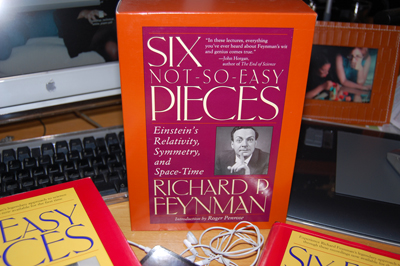
Physics geeks who don't want to revisit the basics may find the second set, Six not-so-easy Pieces, more to their liking. In this set, Feynman lectures on Einstein's Theory of Relativity. We just loaded this set on our iPod. We'll let you know how we made out in a few weeks. [Permalink] - Feynman Lectures on CD
|
|
|
We have been a big proponent of mind-mapping for notes-taking, general organization, and brainstorming. The PersonalBrain is the software implementation of this technique. We have been using it for our various mind-mapping tasks past six years. One feature we have been asking for is a Mac version of this great piece of software.

When Apple moved to the Intel processor, we knew that it would just be a matter of time before the PersonaBrain will be available on OSX. We are happy to say that day has arrived! Actually, it arrived over a year ago, but we were just too busy to notice.

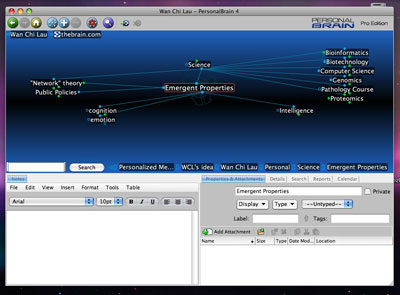
In any case, we recently downloaded version 4.5 for OSX, installed it on our PowerBook, and will be checking out its new features over the next few days. There will be a full review once we have had an opportunity to merge all the brains we have created these past years. [Permalink] - Personal Brain for OSX
|
|
|
|
Last night the Museum Of Science in Boston had a preview of Wild Ocean, the new IMAX film which opens today. We love the MOS and we always want to help spread the word whenever we can. However, we almost didn't go to it because the event was at the end of the day, we were tired, etc... Anyway, we went and were glad we did!

Wild Ocean is a spectacular film about the annual movement of the huge school of sardines (were talking billions of them) which makes it way along South Africa's Wild Coast. This migration also feeds many of the inhabitants (dolphins, sharks, birds, whales, and people) in that region. The footage is stunning, and shows what more of the ocean could be like if we humans were better managers of our sealife harvesting.

The film shows the interdependence of the ocean's large and complex food web, from the little sardines all the way up to the huge whales. The IMAX experience immersed us in the feeding frenzy of sharks, gannets, dolphins, and whales on the migrating sardines. At times it was like being in the middle of the massive, undulating, school of sardines! (Note: Vegetarians may find parts of the feeding frenzy footage less thrilling than their carnivor friends.)
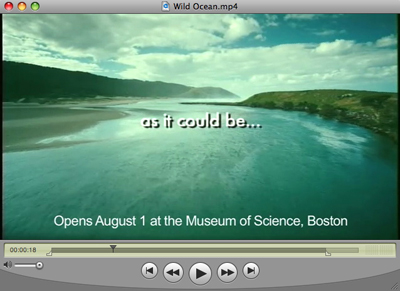
Wild Ocean also looked at the impact of man (industrialized fishing, global warming, etc...) in this ecosystem and stresses the importance of creating marine reserves to allow the seas to sustain its ability to regenerate and restock. The message is that while the ocean's resources are vast, it is not limitless. To share in this bounty, we must manage it at a sustainable level or damage it to the detriment of all that depends upon it. Wild Ocean is showing exclusively in Boston through October 15, and will continue at MOS through February 2009. Go see it today. [Permalink] - Wan Chi Lau
|
|
|
One of our readers, Michael S of NY, sent us an email commenting "Here is one view you won't see with your telescopes."

We agree! This amazing video clip of the moon passing in front of the earth was made by NASA's Deep Impact spacecraft from 31 million miles away. While this vantage point is familiar to all X-Files extraterrestrial visitors, it is the first time for us here the magazine. Definitely "WowUsWednesdays" worthy. [Permalink] - Wan Chi Lau
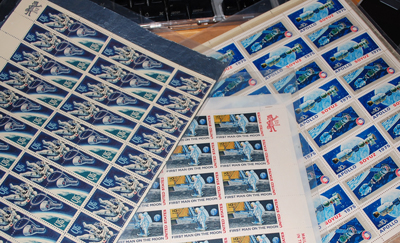
BTW, as a little "Thank You", Michael... pick your favorite, we'll have it out to you today.
|
|
| |
|
Ideas for our daily articles are not always well planned but can come at any time. Today's subject was the result of some pretty loose associations. It started with a conversation about our friend Leslie who is coming to visit from Bermuda. Her maiden name is Robinson, which of course led to the mention of the movie The Graduate. That, in turn, triggered the reciting of the famous lines...
Mr. McGuire: I want to say one word to you. Just one word. Ben: Yes, sir. Mr. McGuire: Are you listening? Ben: Yes, I am. Mr. McGuire: Plastics.

If that conversation was to happen today, the word would be Bioplastics. It is a tiny market now, but with the cost of making petroleum-based plastics rising every day, the future is clear to companies such as Metabolix.
The approach to making bioplatics is to use either bacteria or plants to "grow" plastics. The "stuff" can then be extracted and used to make the things we use everyday. However, Bioplastics is more than that. Some forms of bioplastis are more biodegradable than its counterparts in use today. Some are even compostable! The renewability and degradability of bioplastics are double wins which will help in reducing our "footprint" on the environment. We'll plan to keep our eye on bioplastics and perhaps go chat with the Metabolix folks to get their take on this emerging field. Until then, we'll continue to recycle and reuse our plastics. Perhaps in the future, we'll be able to add "compost" to the list. [Permalink] - Wan Chi Lau
|
|
All of us Apple fanboys know the 3G iPhone is scheduled to be released this Friday. Every gadget site is buzzing with news of "unboxing" and other iPhone related tips and tidbits. We wanted to take RainyDayMagazine readers in a cell phone related, but slightly different direction.

It is pretty obvious that cell phones are now more powerful than many computers from a few years ago. It is likely they will continue to be more so with each iteration. While we can do more with the phones, some are now incorporating them as part of a system to potentially improve health care in the poorer and more isolated regions of the world.
Professor Rubinsky and his team at UC Berkeley has developed an imaging application using the cell phone as the primary visualization platform. You can check out the published paper here and his interview here.
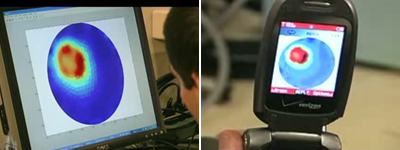
The basic idea is to construct a system which can enable the cell phone to perform ultrasounds, X-rays, magnetic resonance images, and other medical imaging diagnotisc. The possible applications range from detecting tumors to confirming tuberculosis infections to monitoring developing fetuses.
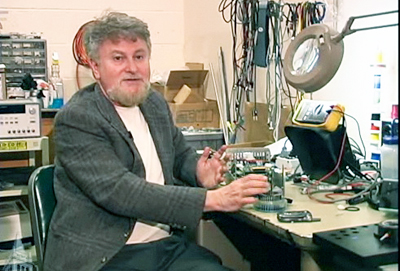
We hope they start doing some work using the iPhone SDK. It would be cool to see the Tricorder as one of the bundled app in a future iPhone release :-) [Permalink] - Wan Chi Lau
|
|
Since we got so many emails asking for more examples, we decided to post few more from our RainyDayGarden series. These were all shot this past weekend using the Casio EX-F1 on a tripod.


We also got a lot of email suggesting additional video ideas. Many of them we have thought of already, some were too odd to attempt even for our intrepid interns, still others were down right illegal in most states. However, we thought seeing more ideas would not be such a bad thing. So if you have an idea for a video, drop us a note with the subject line "Shoot me, baby!" We will select three of the best ideas. One for each frame rate (300, 600, 1200). The winners will get something fun from out pile of stuff. The contest ends at the end of the month. [Permalink] - Wan Chi Lau
|
|
|
The RainyDayPhotography folks had access to the Casio EX-F1 digital camera this weekend. We had heard about this camera's unique high speed shutter and wanted to see if it is as cool as it sounds. We spent a few days with the camera. It was not enough time to sample all of the cameras functions, but we did get a feel for the high speed movie modes.

The image of the bumblebee hovering next to the purple cone flower is a frame pulled out of the 300 fps capture. Click on the images below to see the actual movies of insect (bumblebee, dragonflies) movements at this capture speed. The wing beats are still a little blurry, but definitely WAY better than one can do with any conventional camera or video recorder.
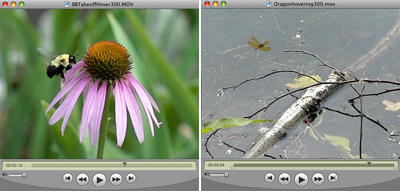
Posted here are series of bumblebees and dragonflies in flight at different frame rates (300fps, 600fps, 1200fps). The image size decreases with the increase in frame rate. This is one of the tradeoffs. The other is light sensitivity. A lot more light is needed to get a good 1200fps movie. None of our indoor ones shot using 1200fps were any good using conventional lighting.

A few obvious lessons learned from our brief encounter with the EX-F1. A tripod is a MUST if you want to get a usable movie. Bright lighting conditions is necessary, but movies captured in direct sunlight is too harsh and contrasty. Match the frame rate to the action. 1200fps is great for getting dragonflies in flight, but not necessary for a "bouncing ball" movie :-)

The Casio EX-F1 is an intriguing camera which opens up a lot of photographic opportunities for those interested in "sampling" the world at a higher frame rate. We have a lot more ideas than time, but unfortunately we had to return the camera today. Maybe we'll get access to another one soon and give those ideas a try! [Permalink] - Wan Chi Lau
|
|
|
Because of our recent obsession with our new higher resolution Nikon D40 digital camera, we thought this news item from IBM was particularly interesting. IBM announced a new type of solid state storage mechanism called "racetrack memory." It has the potential of enabling a 100x increase in storage capacity for the same physical space given today's approaches.
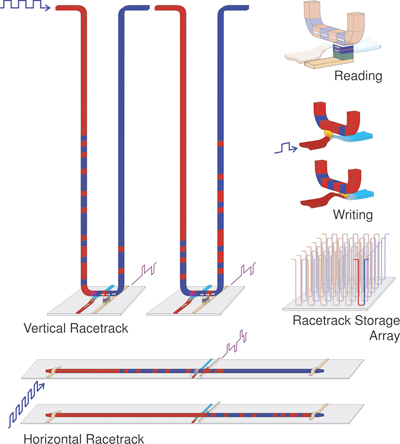
The means an iPod could potentially hold over 3,000 movies or 500,000 songs! We'll let you figure out how many photos that translate to for something the size of a SD Flash card :-) [Permalink] - Wan Chi Lau
|
|
The sun peeked out for a little bit yesterday. We took the opportunity to walk around Jamaica Pond in the "direct beam of the sunshine."

It was still a bit chilly, but signs of Spring were everywhere. There were people jogging, buds are on some of the branches, and nesting activities have started.

We didn't have any problems identifying the various wildlife at the Pond because we have been studing our copy of Bird Song of North America. OK, ducks and cormorants are pretty common :-)
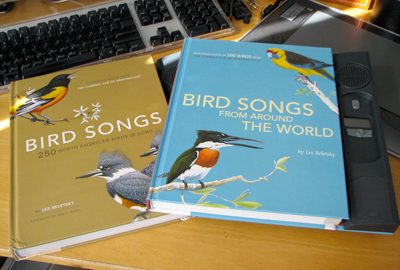
However, how many of you know what a Paradise Tanager or a Streaked SpiderHunter sound like? We thought so. If you want to know, and who wouldn't, you need to get yourself a copy of the Les Beletsky's Bird Songs from around the World.
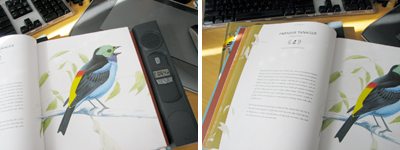
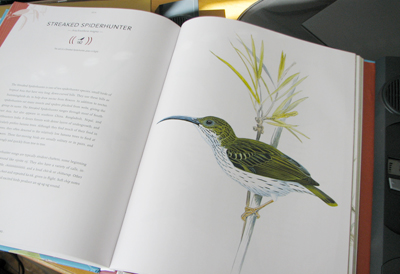
Like the Birds Songs of North America, the illustrations and recordings in the Bird Songs from Around The World are wonderful. So until we book our bird-spotting trip around the world to see and hear them live, we'll just have to be content with Les' book. [Permalink] - Wan Chi Lau
|
|
|
|
Thanks to all you readers who sent us info on our mystery Meade telescope! The general consensus is that the scope is indeed a 2045. Apparently, many of you 2045 owners love it because of its all metal construction and excellent drive mechanism.
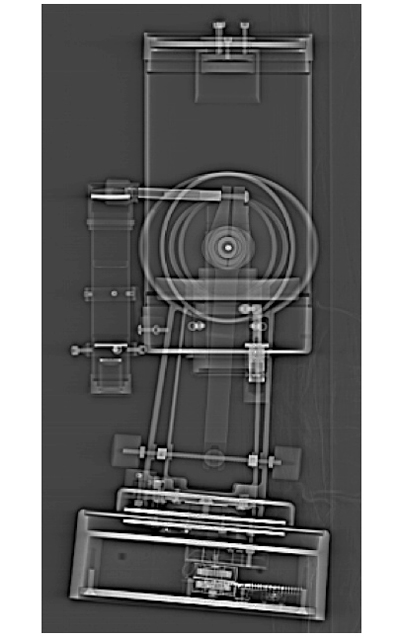
The coolest 2045 info was a link from Brad M on the internals of the scope obtained via a CT Scan. ALL mechanical products should be scanned and their innards revealed in such a fashion! Brad, to show our appreciation for the awesome link, we'll send you the Skeletool once we are done with the review. - Wan Chi Lau (permalink)
|
|
The interns were scanning Craigslist last week and came upon a listing in New Hampshire for a Meade telescope which looked good, but didn't come with any model number. Along with the mystery Meade in the photos was a heavy duty tripod and a lot of accessories (filters, camera mount, eyepieces). However, since it was a Schmidt-Cassegrain design we knew it was not an ETX series scope.

It was decided that the hour drive up North was worth the effort since Burt (the owner) sounded friendly on the phone and assured us the scope was in "like new" condition. Burt was not exaggerating, the scope was pristine. We made an offer and took the entire collection.
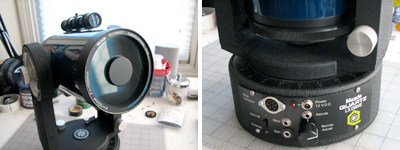

We managed to pack the entire lot into the Boxster (which meant someone hugged a tripod for 40 miles) and will be sorting out the pieces this week. After some initial investigations, we think the scope is a Meade 2045. If you think you know more about this unit or the accessories, drop us a note. The interns could use the help! [permalink] - Mystery Meade
|
|
|
|
Microsoft will be holding their annual research TechFest today and tomorrow. It is a chance for Microsoft's researchers to demo some of the ideas and innovations which have been brewing in their labs, ideas such as an interaction technique for use with small device called "LucidTouch."
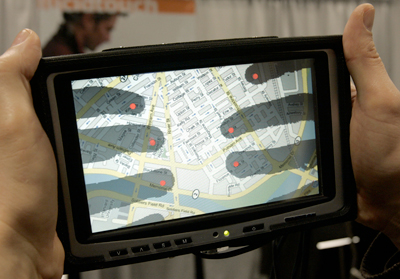
iPhone users sometimes may have wished they had "transparent" fingers for their multi-touch actions. LucidTouch technology allows small screen interactions to be accomplished without covering up the content on display. This illusion is achieved with some clever use of software and camera in the back of the device. Check out Microsoft's LucidTouch and other TechFest demos here. - Wan Chi Lau (permalink)
|
|
Multi-lens, multiple-focus, 100 megapixel camera may sound like the realm of sci-fi. However, Adobe has already built a prototype to show off some of the capabilities of light-field photography.
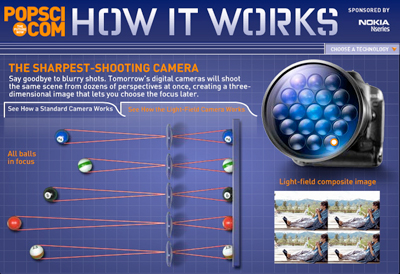
This prototype works using 19 lenses to take images at multiple depths and angles simultaneously. Adobe's software will dynamically enable the viewer to select a combination of independent focal points in various portions of the images. A totally awesome concept. - Wan Chi Lau (permalink)
|
|
Michael Covington is a name which came on to our radar when we started researching books on the topic of AstroPhotography. A few readers who were REALLY into astrophotography clued us in on the "Practical Amateur Astronomy" series published by Cambridge University Press.
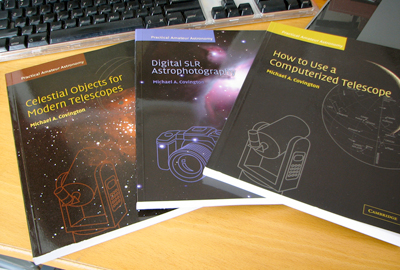
The three volume set covers how to use a modern computerized GOTO telescope, what to look at with these computerized scopes, and how to take pictures of what you are looking at through them.
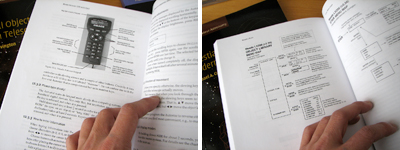
Like other Covington books, these are also based on the author's actual experience with the equipment. The information are both practical and clearly presented. We are sure we'll be referring to these as we start actually getting some field time with our scopes.
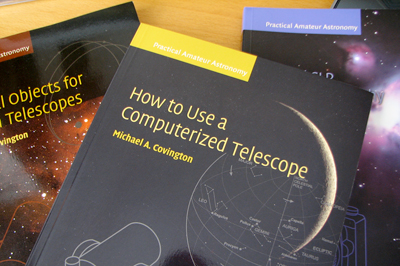
While we have assembled a reasonable collection of different scopes for out first RainyDay StarParty, we don't yet have a computerized telescope with a GOTO function.
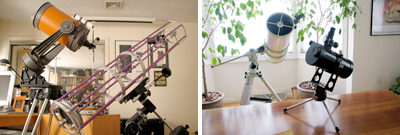
If readers have any recommendations, drop us a line and we'll check them out. However, whatever we end up getting, we are confident that Michael Covington's "How to Use a Computerized Telescope" will be a handy companion guide for us in its use. - Wan Chi Lau (permalink)
|
|
|
|
Last August we mentioned that a group from Canada launched a balloon into near space and took some awesome images with a digital camera. Here is another such a project, this time by Alexei Karpenko. Alexei launched a payload with a GPS, a camera, and various sensors to an altitude of 30km using a high altitude helium balloon.

It seemed appropriate that this WowUsWednesday features another image from another stunning launch by amateur space explorers. Maybe Alexei will "accidentally" get an image of the satellite shoot-down :-) - Wan Chi Lau (permalink)
|
|
Memory is a fascinating emergent property. We all have it, use it everyday, but don't really know exactly how it works. Most of us have no trouble remembering faces, various sounds, and a certain amount of numbers. However, there are some who can remember a LOT more than that. How do they do it? Can anyone do it?
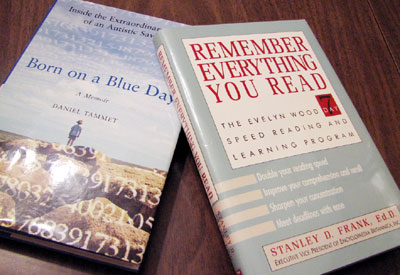
We recently finished two books covering different but related topics on memory. One we had mentioned last March. The other we discovered recently at a used book store in Maine.
The first book, Born On A Blue Day , is by Daniel Tammet. Daniel is a high functioning autistic savant with the ability to perform incredible mental calculations. While this is not unheard of, what is unique is Daniel's ability to describe how he does it. , is by Daniel Tammet. Daniel is a high functioning autistic savant with the ability to perform incredible mental calculations. While this is not unheard of, what is unique is Daniel's ability to describe how he does it.
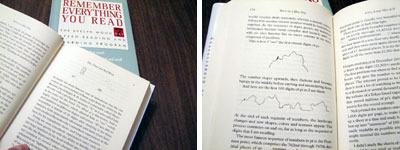
Whatever the reason, Daniel's senses appears to be overlapped. He "sees" numbers as shapes and colors. They also evoke feelings and can have textures. Check out Daniel's visualization of Pi! The book is a fascinating and inspiring read of Dan's journey from childhood to present day.
The second book is "How To Remember Everything You Read" by Stanley Frank. The book is a 11 chapter version of the 7-day Evelyn Wood speed reading and learning program.
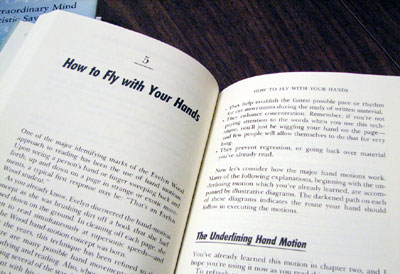
This book is a step by step program on how to drastically improve reading speed and comprehension. We did not work through all of the techniques in the book on our first read, but we will go back and try it in earnest this week.
We came away with renewed appreciation and wonder of the miracle of our brain and its capabilities. We also learn quite a bit about the struggle of those whose mind may work differently than the "average." In the end, if there is one thing we need to remember, is that it is not our capabilities, but how we treat each other that is really what is important. - Wan Chi Lau (permalink)
|
|
|
|
Last Friday we mentioned we got the ThinkBlocks in house. Over the weekend, we started getting emails asking what we thought of them. ThinkBlocks are something different. You can feel it as soon as you pick one up. Here is our FirstLook at the blocks themselves.
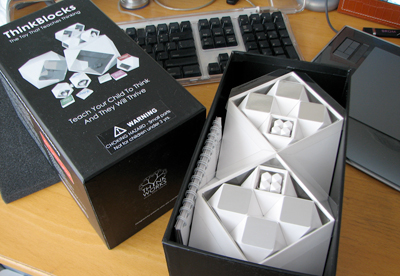
The set came assembled as you see above. The packaging is very compact and elegantly designed. At the bottom of the package are extra blank tiles and a dry-erase pen. When one is done playing with them, all of the pieces may be easily replaced back in the box or just tossed into it... depending on your personality :-)
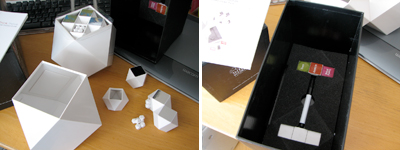
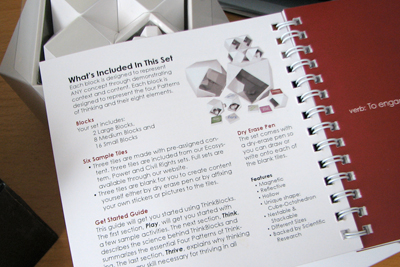
The blocks come in three sizes: large, medium, small. The large and medium sized blocks have an opening on one side. They also have a reflective surface on one of their faces. The smaller sizes blocks can be nested within the larger ones. All the blocks have some magnectic surfaces, enabling them to adhere to each other.


These features are purposeful at many levels. They may be used to demonstrate concepts, to give different views and perspectives, or to stimulate discussions. We'll explore all of them as we play with the blocks in the coming months. - Wan Chi Lau (permalink)
|
|
The final phases of building the Hugo Newtonian telescope are putting together the tripod and attaching the tube to the base. Both procedures were very straight forward and can be done without tools.
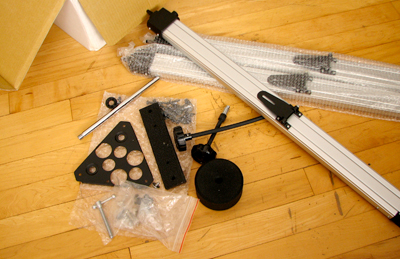
The legs of the tripod came preassembled. There are a lot of screws to this step and we found it best to lay everything out on the floor before starting the assembly process.
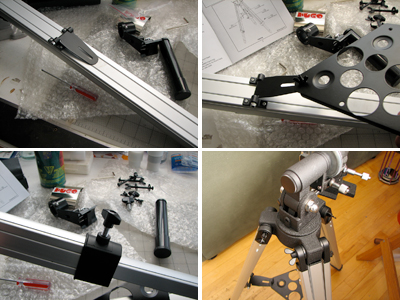
The legs of the tripod are made of aluminium. They are braced by a triangular plate which attaches to an anchor, via wing nuts, at each of the legs. The tripod head is then secured to the legs to form a stable assembly.

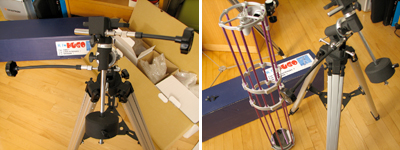
At this point, the tripod assembly is almost complete. There are two adjustment knobs which must be attached. They allow for fine control of the orientation of the telescope when tracking and observing. To make the scope easy to orient, a counter weight is attached to balance the tube during use.

Once the tripod had been assembled, the telecope tube may be mounted on the base. The mounting plate mates the tripod and the telescope tube. When securely attached, the Hugo telescope assembly is complete.
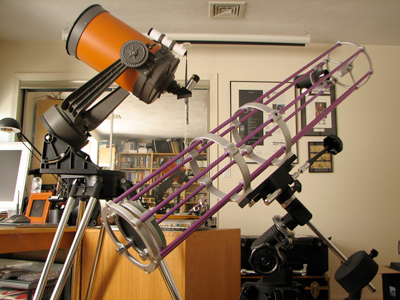
Next article will be on calibrating the Hugo and getting it ready for use. We are all eager to see how this scope will perform once it is all set up. - Wan Chi Lau (permalink)
|
|
|
Many readers of RainyDayMagazine know we are huge fans of toys, tools, and techniques which may improving our cognitive abilities. Why? The brain is one of the most "hackable" gadget out there, everyone can do it, and it is just great fun!
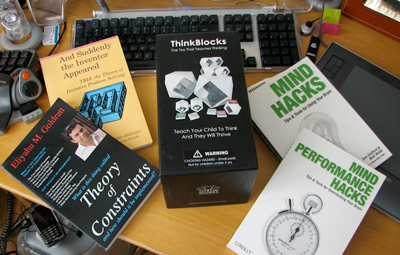
A few weeks ago, we got an email from Beverly C. who pointed us to a product called ThinkBlocks she thought would be of interest to readers of RainyDayMagazine. We checked it out and was immediately fascinate by its potentials.
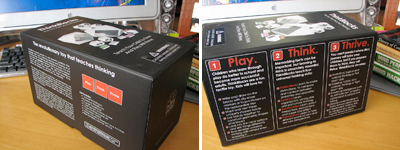
ThinkBlocks are designed for teaching the act of "thinking." These blocks were not dreamed up by some New Age touchy-feely guru. They are based on Dr. Cabrera's theories backed by research done at Cornell University.
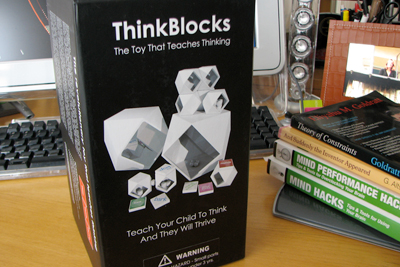
ThinkBlocks are designed for teacher and students of all ages. We are not quite sure how to do it yet, but we would like to get the reaction to the ThinkBlocks from a few different populations. It would be interesting to see how different groups would interact with this unique product. We'll have a FirstLook of the ThinkBlocks next week. - Wan Chi Lau (permalink)
|
|
|
This flashlight (The Torch) from WickedLasers may look like an ordinary flashlight, but with an output of 4100 lumens, it is anything but. The Torch is the WORLD's strongest flashlight...much brighter than anything we have looked at in the past!
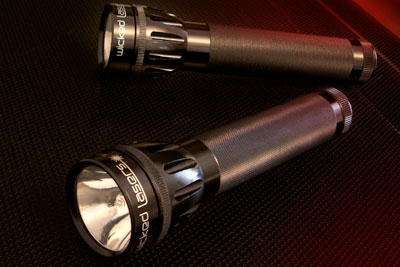
How much light is 4100 lumens? Well, it is enough to cook an egg and light stuff on fire! This is not something you want in your checked luggage.
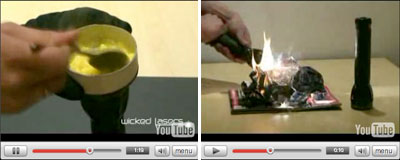
So how much will all of this luminosity set you back? How about $300? Now before you think that $300 is too much for a flashlight, consider the cost of the Polarion Helios (previous record holder) at $2200! At 1/8th the price, the WickedLasers Torch is really a bargain! - Wan Chi Lau (permalink)
|
|
|
Jan 20,2008 (WeekendEdition) |
A hard copy of Michael Covington's Astrophotography for the Amateur may be difficult to local at your local book store. We had to do a little digging on the Web before we were able to local a used copy.
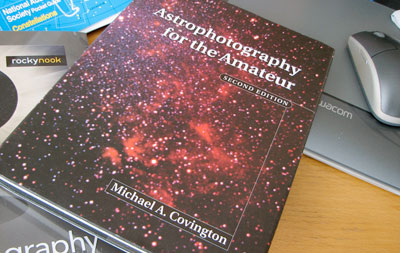
There are some paperback units floating around on Amazon and EBay. We wanted the hard copy because Covington's coverage of the topic is both theoretical and practical.
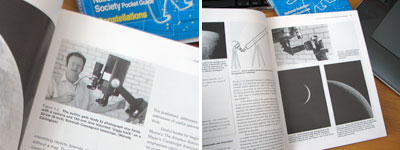

There are lots of hight quality color photos, diagrams, and illustrations in the book. A major bonus for us is many of the examples and photos in the book were done using a similar Celestron C8 telescope as what we'll be using for our own astrophotography projects.
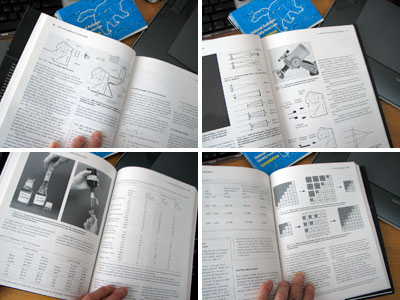
Covington's approach to the book is much more technical compared to Seip. For reader wanting a with a more indepth discussion on digital filtering (convolution, 3x3 sharpening matries, etc...) and other signal processing techniques, Covington covers these topics in a manner that is both understandable and relevant.
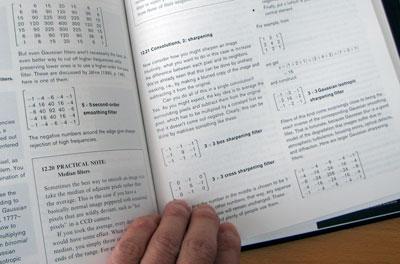
Astrophotography for the Amateur is both a great "how-to" manual as well as an excellent reference text. If you are serious about astrophotography and is looking for something which will give you a stronger theoretical background on many of the related topics (optics, scope construction, digital signal processing), then you need to make sure you have a copy of Covington's book within easy reach. - Wan Chi Lau (permalink)
|
|
Jan 19,2008 (WeekendEdition) |
According to our YES COSMO watch, there will be a full moon tonight. The timing is perfect as we had spent the weekend reading about astrophotography :-) We know what you are thinking... some of us REALLY need to get out more.
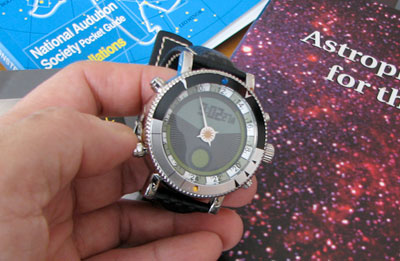
Let us assure you, the topic of astrophotography is the ultimate convergence of all things a true geeks love: it involves loads of technical gear, there is a fanatical (yet friendly) user base, and the topic is ripe with tons of hacks and project opportunities.

We have been researching this subject for our first RainyDayScience topic and have come across some excellent books we thought we should share with those who may be thinking along these same lines.
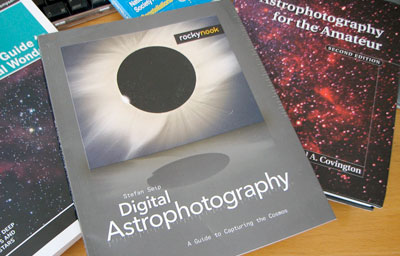
Amateur astrophotography has benefitted greatly in recent years by the availability inexpensive digital cameras. Webcam and small point-and-shoot digital cameras of exceptional quality may be had for less than $200! Stefan Seip has written an excellent introduction the use of digital equipment and techniques in this area.
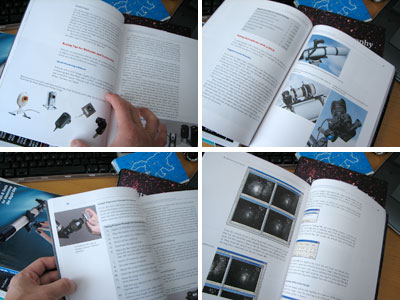
The book covers the entire range of equipment (webcam, digital cameras, DSLR, special purpose Astro gear) available to the amateur astrophotographer. He discusses the relative benefits (image quality, ease of use) and trade-offs (cost, complexity) of each type of equipment.

Topics such as post-capture image processing and manipulation are also covered. There are some very interesting discussions on how to take advantage of the digital nature of the images to bring out details and colors not possible with traditional film techniques. We expect we'll be referring to this book frequently as we strive to improve our on our astrophoto shots. - Wan Chi Lau (permalink)
Robert and Barbara Thompson have written two books which will make it easier for someone just getting started in Astronomy or have been in the hobby for a while.
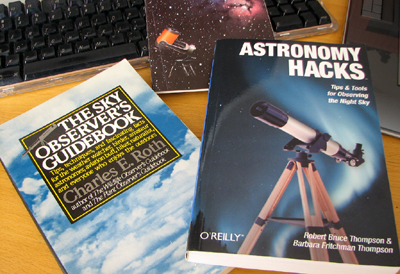
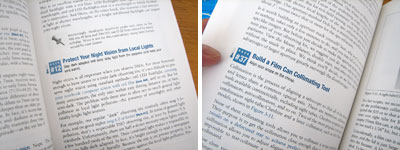
Astronomy Hacks is a fantastic collection of observing tips, telescope projects, and knowledge obtained from years of practical hands-on field work. This book should be read by any interested in Astronomy before they even think about buying their first telescope. - Wan Chi Lau (permalink)
The night sky is a big place. Finding interesting things to look at is pretty easy. Finding what you are looking for is a bit harder :-)
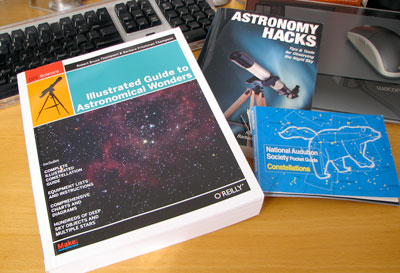
The Illustrated Guide to Astronomical Wonders is a collection of interesting astronomical destinations. The images in the book are shown as they would appear under actual observation out in the field. They are also accompanied by directions and a "roadmap" on how to get there.

The format is practical and easy to use. This guide is designed to allow the user to "plan a trip" as well as take it "on the road." - Wan Chi Lau (permalink)
|
|
|
GoTo mounts are great. Making one for your own telescope is even better. Don't know how? Check out the DIY write-up on Steve Bedair's site. It is not a step-by-step instructable, but the photo series on building one for the Celestron C-11 was enough for a mention on WowUsWednesday.
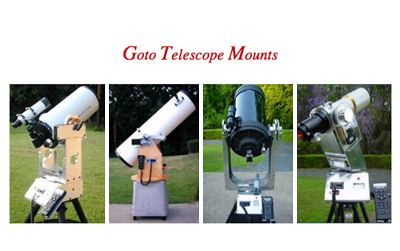
Steve also recommended joining Yahoo!'s RoboScope forum. We did and found a great collection of photo album on various homemade Goto mount.
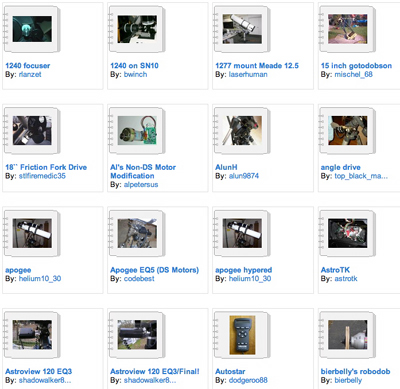
Very cool! So many projects, so little time. - Wan Chi Lau (permalink)
|
|
In early December, we unpacked and gave readers a quick FirstLook at the Hugo telescope. The Hugo is unlike any Newtonian reflector telescope currently on the market.
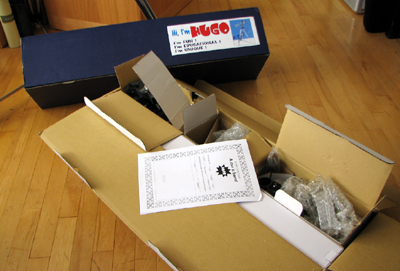
Some assembly (tube, tripod) is required before the Hugo is ready to be used. The process is part of the fun of the Hugo. It teaches the owner about the parts, the scope's construction, and all of the mechanics involved in making the telescope work.

The assembly process, amazingly enough, is very straightforward. In putting it all together, we learned quite a bit about how Newtonian telescopes work.
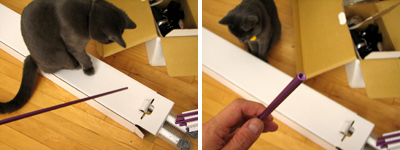
The Hugo does not use a cylinder to hold the eye piece, diagonal and primary mirrors in place. Instead, a tube is constructed using six aluminum rods and four rings. When everything is put together and tightened, the entire structure is very rigid.

To form the tube, two inner rings must first be aligned and the rods inserted. The two inner rings will eventually need to be properly spaced so they can be fitted to the tripod. At this point, there is no need to lock their positions.
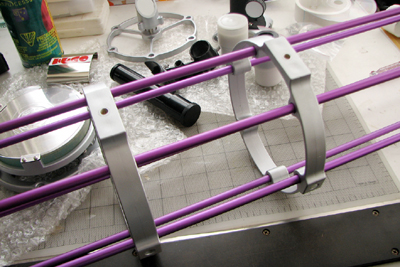
The next piece to go on the rods is the eye piece mount. Once threaded onto the rods, the mount may be tighted in place. Final placement can be adjusted once it is time to align all of the optics.
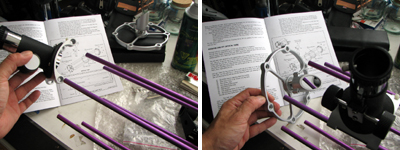
The diagonal mirror is mounted on one of the end rings, the primary mirror on the other. Since the diagonal mirror will rotate into position, there is no need to worry about the mirror's orientation during assembly.

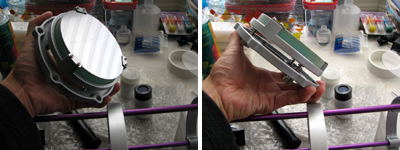
These two end rings are fastened to the rods by stainless steel bolts. Care should be taken not to overtighten the bolts. The diagonal mirror should be attached first. Once in place, put the entire structure on the floor and carefully lower the primary mirror into position and attach it to the rods.

When all the bolts have been properly fastened, the tube should be very rigid. Turn the entire assembly so that the primary mirror is closest to the floor. This is a more stable way to stand the tube out of the way while proceeding on to the tripod assembly step. We'll have more of the Hugo construction next week. - Wan Chi Lau (permalink)
|
RainyDayScience 2008
RainyDayScience 2007
|
|
|



































































































































































